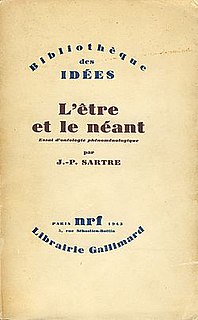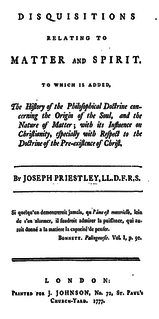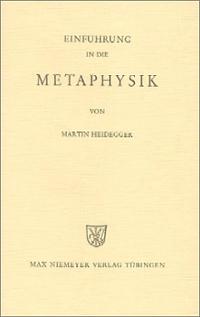 W
WAppearance and Reality is a book by the English philosopher Francis Herbert Bradley, in which the author, influenced by Georg Wilhelm Friedrich Hegel, argues that most things are appearances and attempts to describe the reality these appearances misrepresent, which Bradley calls the Absolute. It is the main statement of Bradley's metaphysics and is considered his most important book. The work was an early influence on Bertrand Russell, who, however, later rejected Bradley's views.
 W
WBeing and Nothingness: An Essay on Phenomenological Ontology, sometimes published with the subtitle A Phenomenological Essay on Ontology, is a 1943 book by the philosopher Jean-Paul Sartre. In the book, Sartre develops a philosophical account in support of his existentialism, dealing with topics such as consciousness, perception, social philosophy, self-deception, the existence of "nothingness", psychoanalysis, and the question of free will.
 W
WBeing and Time is the 1927 magnum opus of German philosopher Martin Heidegger and a key document of existentialism. Being and Time had a notable impact on subsequent philosophy, literary theory and many other fields. Its controversial stature in intellectual history has been favorably compared with several works by Kant and Hegel.
 W
WConcluding Unscientific Postscript to the Philosophical Fragments is a major work by Søren Kierkegaard. The work is a poignant attack against Hegelianism, the philosophy of Hegel, especially Hegel's Science of Logic. The work is also famous for its dictum, Subjectivity is Truth. It was an attack on what Kierkegaard saw as Hegel's deterministic philosophy. Against Hegel's system, Kierkegaard is often interpreted as taking the side of metaphysical libertarianism or freewill, though it has been argued that an incompatibilist conception of free will is not essential to Kierkegaard's formulation of existentialism.
 W
WThe Critique of Pure Reason is a book by the German philosopher Immanuel Kant, in which the author seeks to determine the limits and scope of metaphysics. Also referred to as Kant's "First Critique", it was followed by the Critique of Practical Reason (1788) and the Critique of Judgment (1790). In the preface to the first edition, Kant explains that by a "critique of pure reason" he means a critique "of the faculty of reason in general, in respect of all knowledge after which it may strive independently of all experience" and that he aims to reach a decision about "the possibility or impossibility of metaphysics."
 W
WThe Dialectic of Essence: A Study of Plato's Metaphysics is a 2003 book by Allan Silverman in which he offers an account of Plato's metaphysics. Silverman believes that the proper way to make sense of the metaphysics is to consider carefully what Plato says about ousia (essence). This book is focused on three basic aspects of the metaphysics: the theory of Forms, the nature of particulars, and Plato's conception of the nature of metaphysical inquiry.
 W
WDisquisitions relating to Matter and Spirit (1777) is a major work of metaphysics written by eighteenth-century British polymath Joseph Priestley and published by Joseph Johnson.
 W
WThe Doctrine of Philosophical Necessity (1777) is one of the major metaphysical works of 18th-century British polymath Joseph Priestley.
 W
WElbow Room: The Varieties of Free Will Worth Wanting is a 1984 book by the American philosopher Daniel Dennett, in which Dennett discusses the philosophical issues of free will and determinism.
 W
WFirst and Last Things is a 1908 work of philosophy by H. G. Wells setting forth his beliefs in four "books" entitled "Metaphysics," "Of Belief," "Of General Conduct," and "Some Personal Things." Parts of the book were published in the Independent Magazine in July and August 1908. Wells revised the book extensively in 1917, in response to his religious conversion, but later published a further revision in 1929 that restored much of the book to its earlier form. Its main intellectual influences are Darwinism and certain German thinkers Wells had read, such as August Weismann. The pragmatism of William James, who had become a friend of Wells, was also an influence.
 W
WIn the Shadow of the Silent Majorities, Or, the End of the Social is a 1978 philosophical treatise by Jean Baudrillard, in which he analyzes the masses and their relation to meaning. The masses are presented as the ideal form of resistance to the social.
 W
WIntroduction to Metaphysics is a revised and edited 1935 lecture course by Martin Heidegger first published in 1953. Heidegger suggested the work relates to the unwritten "second half" of his 1927 magnum opus Being and Time. The work is also notable for a discussion of the Presocratics and for illustrating Heidegger's supposed "Kehre," or turn in thought beginning in the 1930s—as well as for its mention of the "inner greatness" of Nazism.
 W
WKant and the Problem of Metaphysics is a 1929 book about Immanuel Kant by the German philosopher Martin Heidegger. It is often referred by Heidegger to simply as the Kantbuch (Kantbook). This book published as volume 3 of the Gesamtausgabe.
 W
WLanguage, Truth and Logic is a 1936 book about meaning by the philosopher Alfred Jules Ayer, in which the author defines, explains, and argues for the verification principle of logical positivism, sometimes referred to as the criterion of significance or criterion of meaning. Ayer explains how the principle of verifiability may be applied to the problems of philosophy. Language, Truth and Logic brought some of the ideas of the Vienna Circle and the logical empiricists to the attention of the English-speaking world.
 W
WThe Logic of Sense is a 1969 book by the French philosopher Gilles Deleuze. The English edition was translated by Mark Lester and Charles Stivale, and edited by Constantin V. Boundas.
 W
WMeditations on First Philosophy, in which the existence of God and the immortality of the soul are demonstrated is a philosophical treatise by René Descartes first published in Latin in 1641. The French translation was published in 1647 as Méditations Métaphysiques. The title may contain a misreading by the printer, mistaking animae immortalitas for animae immaterialitas, as suspected by A. Baillet.
 W
WPhilosophical Explanations is a 1981 metaphysical, epistemological, and ethical treatise by the philosopher Robert Nozick.
 W
WPhilosophical Problems of Space and Time is a book about the philosophy of space and time by the philosopher Adolf Grünbaum. It is recognized as a major work in the philosophy of the natural sciences.
 W
WThe Reign of Quantity and the Signs of the Times is a 1945 book by the French intellectual René Guénon, in which the author purports to give a comprehensive explanation, based on tradition, of the cyclical conditions that led to the modern world in general and to the Second World War in particular. The book was published with the support of Jean Paulhan from Gallimard, who created a collection exclusively dedicated to "Tradition" in order to publish Guénon.